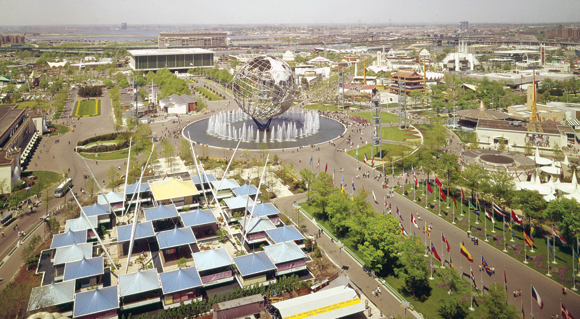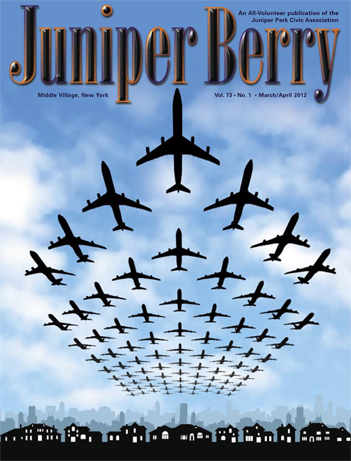The Juniper Berry has hosted in its pages, articles on the wildly popular story of Fairyland Amusement Park, Freedomland and the World’s Fair of 1939. It seemed only right to complete the series of NYC exhibitions with a story on the World’s Fair of 1964-65. So, to begin the once upon a time story of the 1964-65 World’s Fair, let’s give it a background check of the times.
It was before the turbulence of the Vietnam War and the intensity of the civil rights struggles took hold that America even found the time to host the 1964-65 World’s Fair in New York City at the same site as the 1939 World’s Fair. Lyndon Johnson was our President and he was launching his Great Society. To be sure, America was still reeling from the assassination of President Kennedy in 1963.
The year 1965 also saw a first; Pope Paul VI became the first reigning pontiff ever to visit the Americas. He flew to New York to address the United Nations in a plea for peace, which he spoke in French. From this writer’s viewpoint, what a high to actually come that close to the person who Catholics believe represents the Vicar of Christ on Earth and the spiritual head of the Church, which I remember quite clearly from my days as a Catholic school student!
As far as organizing a World’s Fair was there anyone more qualified in that time period than the “Master Builder” himself, Robert Moses? Moses came to power in the 1930s and he served as the City’s Parks Commissioner for many years. He’s responsible for much of our park system as well as the brains behind our City’s highway infrastructure as we know it today. He was a natural to get a World’s Fair in 1964 off the ground because he had the expertise to raise money for large public projects.
The Fair’s theme was “Peace Through Understanding” and American corporations dominated the exhibitions. The Fair also saw the birth of the stainless steal model of the earth named the Unisphere and it still stands proudly today at its original site, Flushing Meadow Corona Park in the Borough of Queens, New York.
The 1939/1940 and 1964/1965 New York World's Fairs were the only significant world's fairs since the formation of the BIE to be held without its endorsement. The lack of BIE endorsement also resulted in other changes in the Fair. For instance, major foreign exhibits were absent but since NYC was at its height of economic power and prestige, smaller nations saw it as an honor to be included in the Fair.
There were 140 pavilions featured and since it was the birth of the space age the theme was “Man in a Shrinking Globe in an Expanding Universe.” The United States seized the opportunity to strut its corporate colors with big time American firms like General Motors, Chrysler, US Steel, Bell Telephone Company, General Electric, Westinghouse and RCA and let’s not forget the leisure time drink of choice, Pepsi Cola. Nowadays it would be labeled a big public relations stunt to attract visitors and polish corporate image supported by all the glitz and glamour from the Economic Capital of the World, New York City.
Monetarily, millions of dollars were invested. However the Fair did fall short of its economic goal and although there were heroic attempts to attract visitors, it still lost money. That meant that ultimately Flushing Meadow Park in Corona didn’t get the money needed to finish the park and make it a showcase for the Borough of Queens as was originally anticipated by “Master Builder,” Robert Moses.
The United States’ Pavilion was titled “Challenge to Greatness.” This Pavilion focused on President Lyndon Johnson’s “Great Society” initiative. It featured a 15-minute ride through a filmed presentation of America. The novelty of this presentation had the participants seated in moving grandstands riding past movie screens that slid in, out and over the path of the traveling audience. There were also tributes to President John Kennedy who had broken ground for the pavilion in December 1962 (photo, right) but had been assassinated in November 1963 less than one year before the Fair opened.
One of the most popular exhibits was in the Vatican Pavilion, which featured what was considered Michelangelo’s masterpiece of Renaissance sculpture, La Pieta, created by him in 1499. To be sure there was the utmost security and vigilance so that this beautiful sculpture could have a safe haven in the United States during its two year run at the World’s Fair of 1964-65.
Also a big crowd pleaser was the Belgian Village one of the most striking of the international pavilions which was four acres in size. This exhibit was a unique near perfect copy of a 19th Century Belgium village replete with a beer hall, a replica of a church from the 15th century, approximately 100 houses with Belgian themes, a bridge and a canal built out of stone, an 1898 carousel, streets lined with small shops selling handcrafts and folk dancers for entertainment. The big treat at the Belgian Village was the debut of the “Bel-Gem Brussels Waffle” which was a combination of waffle, strawberries and whipped cream. Who could resist trying that delicious combination of epicurean delight?
Perhaps the most novel corporate pavilion was Pepsi Cola’s with a tunnel of love style water ride developed by Walt Disney called “It’s a Small World – A Salute to UNICEF.” There were familiar scenes like France’s Eiffel Tower, a Dutch windmill and India’s Taj Mahal located in various areas of the Pepsi Cola exhibit. The animated figures danced and played with animals while they sang, in various languages, the song “It’s a Small World.” To this day “It’s a Small World” still reigns as a popular attraction at Disneyworld in Florida.
Another more notable exhibit came from the General Motors Corporation which featured a show called “Futurama,” where participants were seated in moving chairs as they glided past detailed scenery showing what life might be like in the “near-future.” This exhibit turned out to be one of the most popular at the Fair. They estimated that about 26 million people took the Futurama journey during the Fair’s two-year run.
The 1964-65 World’s Fair also served as an opportunity to showcase independent films. A religious film titled “Parable” was shown at the Protestant Pavilion and it depicted Christ as a clown in a traveling circus. This film was the inspiration for the very popular musical “Godspell.”
Evangelist Billy Graham sponsored his own pavilion where the film “Man in the Fifth Dimension” was shown in a specially designed theater equipped with audio equipment that enabled viewers to listen to the film in several different languages, a definite innovation in the 1964 time period.
Let’s not do an article attempting to capture the essence of the World’s Fair of 1964-65 without talking about the delicious cuisine spotlighted at the 112 restaurants at the Fair. Many featured international dining and “continental cuisine” at a time when restaurants of this type were not common in America with the exception of perhaps half a dozen large cities. Spain, India, Japan, Africa, Lebanon, and Jordan made contributions with their cuisine and one could experience a luau at the Five Volcanoes Restaurant in the Hawaiian pavilion.
As previously mentioned, the real treat at World’s Fair 1964 had to be the birth of the “Bel-Gem Waffle” which was a hit at the Belgian Village exhibit but available all over the Fair grounds because it was delicious, a World’s Fair star!
Similar to the experience of the World’s Fair of 1939, which we spotlighted in the Juniper Berry previously, the World’s Fair of 1964-65 was not without big time controversy with accusations of financial mismanagement. By the end of the 1964 season, Robert Moses and certainly the press, always hungry for that juicy story, began to realize that there would not be enough money to pay the bills and the reasons why were too convoluted for the purposes of this article. However, to give the loss a framework to its predecessor, the 1939-1940 New York World’s Fair returned 40 cents on the dollar to bond investors and the 1964/1965 Fair returned only 19.2 cents on the dollar.
There you have it, a snapshot look at the World’s Fair of 1964-65, definitely a bygone era in American history. It peaks interest in the thought of possibly another World’s Fair in the United States. To be sure that with Internet capabilities and technology as sharp as it is currently one could only imagine the scrutiny that would dictate the playing field of such an event, to say nothing of the political correctness that would be hovering over all exhibits. I guess I just stated reasons why another World’s Fair in America sounds like an unrealistic possibility! However, I have faith in the human spirit that always wins with the ever-prevalent desire to go forward with what seems impossible. The real problem would be finding enough honest participants so that at least once in our lifetime there could be a World’s Fair in the United States of America that actually MAKES money! Now there’s a plan!



